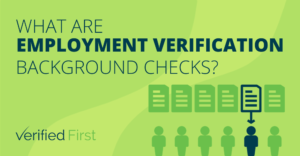
So you have an open role at your company and obviously want the best candidate for the role. You’re likely combing through multiple resumes and cover letters, delicately deciding who could be the right fit for the role. That’s the first step of the hiring process anyway – determining if the potential candidate has the proper knowledge, skills, and experiences to perform the job at hand.
But did you know that approximately 72% of people have lied on their resume? Of these respondents, 40% lied about the length of experience, 37% lied about skills or abilities, 29% lied about the length of previous employment, and 28% lied about the responsibilities of the previous role.
A white lie on a resume does not automatically mean you shouldn’t hire the potential candidate. However, some lies have the potential to lead to hiring an unqualified individual or harming your company’s reputation. That’s why countless organizations like yours are implementing employment verifications in their background screening process.
Continue reading to learn more about what employment verifications are, why you should conduct employment verifications, and how to easily start employment verification screening with Verified First.
Employment verifications confirm a candidate’s previous work history during the pre-employment screening process. Employment verifications help ensure that the potential candidate has the experience, skills, and abilities necessary to perform the responsibilities of the role by uncovering false employment claims, gaps in employment, and discrepant job titles. Typical aspects of employment verifications include:
Employment verifications typically verify three to seven years of employment history, however, this can change depending on the duties of the position held. Some state laws or company policies can restrict the type of information past employers can share during employment verifications. For example, some companies prohibit sharing a candidate’s reason for leaving or eligibility for re-hire.
Employment verifications can give you additional insight into your candidate’s work history, empowering you to make more informed hiring decisions. Let’s explore the ways verifying a candidate's employment history can improve your hiring strategy:
According to the U.S. Department of Labor, the average cost of a bad hire is roughly 30% of their first-year earnings. With so much at stake, you need to be able to quickly and accurately vet out qualified candidates for the position. Utilizing employment verification checks during the background screening process helps you identify candidates with the necessary skills and qualifications for the role, saving you time, energy, and money.
Good employees are important no matter what industry you work in, but certain skilled positions require experience and time invested in the role to be the best fit for the role. By verifying a candidate’s employment history, you can confirm they have the necessary skills and abilities to carry out the duties of the role.
Hiring a candidate with false credentials or experience can pose several threats to your organization including damaged reputation, theft and fraud, compliance fines, and more. Employers can face serious backlash and negligent hiring lawsuits if they fail to thoroughly vet a candidate during the pre-employment screening process if the candidate ends up causing harm to others. Employment verifications help you protect your company and its people.
Like pre-employment screening, employment verifications can help you comply with state, federal, and industry-specific regulations. Education, healthcare, transportation, and insurance organizations may have stricter experience/employment criteria in order to perform the role legally. Hiring someone without the proper qualifications can expose your business to significant liability and legal costs.
Some organizations may choose to conduct DIY employment verifications, but the most effective way to thoroughly vet your candidates is by partnering with a background screening provider. The right background screening provider will let you fully integrate and automate background screening into your recruitment and hiring process. Screening providers can verify information quicker, more efficiently, and more accurately than conducting employment verifications on your own.
There’s no better feeling than bringing on an excited new hire, and that’s why employment verifications shouldn’t slow down your hiring process. Verified First is committed to helping you hire and onboard candidates with confidence. Our average turnaround time is 46.7 hours (compared to the industry average of 2-5 days), with a 92.6% success rate (and 97% customer satisfaction rate).
Our verification specialists conduct research and start making calls as soon as an employment verification is requested. If our team establishes that previous employers are using third-party vendors, they will reach out to applicants to gather W2s and/or pay stubs to verify employment.
Verified First is focused on providing a solution that fits your needs. Our processes can be very flexible to allow our clients to create their own process restrictions and modifications. Are you interested in adding employment verifications to your background screening process?
This is the second installment of our Verifications series. If you’d like to read the first blog and learn more about Education Verifications, click here.